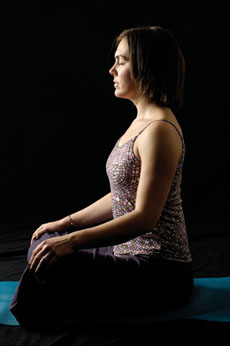By Susan Brown ’08

I tried yoga for the first time in 1998. “Too slow. My mind works much faster than what I am being instructed to do. This is boring,” I thought, as I transitioned from the standing Warrior II pose to a Triangle.
I came back to yoga five years later with a stronger appreciation for the practice and a desire to better “listen” to my heart, mind, and body—to connect not only physically with my body but also emotionally. This time, as I moved from Warrior II into Triangle, I consciously noticed the openness of my hips and the deep stretch through my legs as the stress-caused tension that had become locked in this area melted away. With yoga, I found a new freedom from being willing to put myself in a brand new situation … and in turn a whole new way of viewing the world. I decided it was time to switch careers from biopharmaceutical research and development, where I had worked as a chemical engineer for almost five years, and return to school to become a nurse.
Last fall I began teaching yoga at the School of Nursing to any fellow students, faculty, and staff who were interested. I had discovered that there is a great deal of stress and anxiety that comes with being in the nursing program. In addition, I found that nursing school can be very focused on the technical aspect of helping patients but at times forget the important balance of also responding to the patient’s emotional and spiritual needs. I wanted to provide an opportunity for my classmates—as well as the faculty and staff—to experience the relaxation, mind/body centering, and physical strengthening and flexibility that only yoga provides.
Each week, between five to 10 people turned out in the Carpenter Room for my 45-minute session of Vinyasa-style Hatha yoga—a type that works on balancing opposites: masculine and feminine, solar and lunar, energizing and relaxing. The focus for all of us in the class was to think about breathing, feeling, listening to the body, and letting go of competition, judgment, and expectations. Vinyasa-style is the order, or flow, in which each pose occurs during the class. Thus, the poses are linked in such a way to increase strength, flexibility, balance, and endurance.
The grateful feedback I received from my students was wonderful. “I feel so relaxed. Thank you!” was a commonly voiced sentiment. My hope is that this knowledge of yoga basics will encourage my nursing school classmates to suggest yoga as a modality for healing and health to the hundreds or thousands of patients they will assist in their careers.
Based on my clinical experience, patients are very receptive to yogic deep breathing techniques during dressing changes or painful, anxiety-causing events. Patients like—and need—to be heard, and sometimes just discussing breathing techniques opens the patient to voice concerns or worries, which can be extremely therapeutic.
I continue to practice two to three times a week. I want to stay connected with my own emotional and spiritual being to ensure that my personal balance remains intact. This will allow me to be the nurse that I strive to be in a world that is greatly out of balance and constantly struggling to find equilibrium. Yoga and deep breathing provide my balance. My wish for every individual is to find one’s own balance in something that brings peace to the heart. “The healing miracle begins with one.”